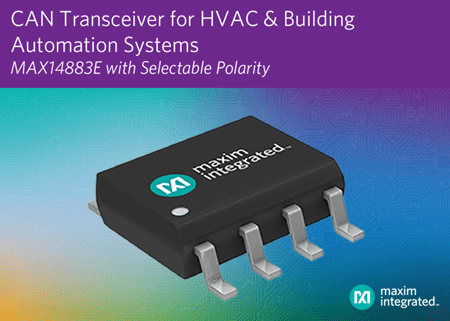Recently, Maxim announced the introduction of the MAX14883E Control Area Network (CAN) transceiver to quickly resolve installation errors in heating, ventilation and air conditioning systems (HVAC) and building automation systems. This article refers to the address: http:// The CAN bus has been widely used in the industrial field. In harsh industrial environments, it is easy for the operator to reverse the CANH (CAN bus high side) and CANL (CAN bus low side) when installing the system. This causes users to spend a lot of time and money to find and resolve installation errors, increase the number of trips to and from the site, and bear the risk of communication failures. The MAX14883E is a polarity-selectable, high-speed CAN transceiver tailored for industrial networking applications to quickly resolve installation errors and ensure communication reliability. The device provides a polarity select input (POL) that exchanges CANH and CANL I/O and corrects the reversing field cable via software. In addition, the MAX14883E offers ±60V fault protection, up to ±22kV ESD protection (HBM), and the CANH and CANL buses can withstand up to ±25V common-mode input range to ensure communication reliability. The transceiver supports CAN bus maximum communication rate (small network rate up to 1Mbps), 5V single-supply (VCC) power supply, and logic power input (VL) to ensure that the device is compatible with 1.8V to 5V logic levels. The MAX14883E is available in a narrow 8-pin SOIC package and operates over the -40°C to +125°C temperature range.
USB Cable :1.Type A: almost every USB cable has a standard flat rectangular interface at one end. Most computers have a usb-a port to connect to only one USB port.
2.Type-B: almost square connector for printers and other active devices connected to computers. They are not common now because most devices have been moved to smaller connections.
3.Mini USB: a smaller connector type that was standard for mobile devices before micro USB. It's not common today, but you'll see it on some cameras, PlayStation 3 controllers, MP3 players, etc.
4.Micro USB: the current standard for mobile and portable devices, even smaller than Mini USB. Although you can still find micro USB on smartphones, tablets, USB battery packs and game controllers, some have turned to usb-c
5.Type-C: the latest USB standard, which is a reversible cable, promises higher transmission speed and higher power than previous USB types. It can also take into account a variety of functions.
USB Cable ShenZhen Antenk Electronics Co,Ltd , https://www.antenkcon.com